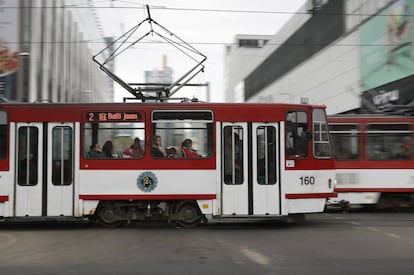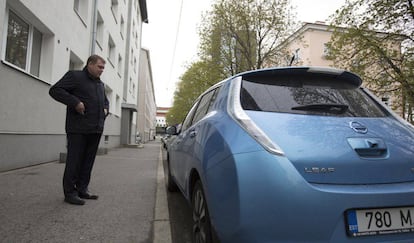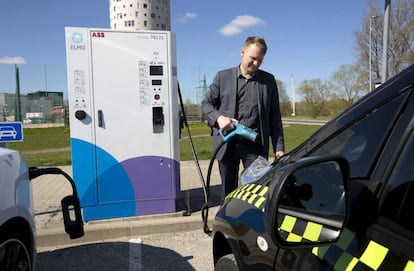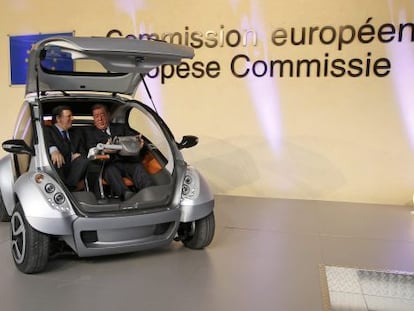How Estonia persuaded drivers to go electric
The Baltic state was the first country to set up a nationwide network of recharging stations for electric vehicles, as well as offering a range of incentives to encourage their use. But the end of subsidies has seen sales fall drastically. The Estonian model shows that without government assistance, uptake of electric vehicles is slow

It’s been a long time since Ülle Jehe last set foot in a gas station. Filling up is no longer an unavoidable chore, even though she drives on a daily basis through the cobblestone streets of the historic center of Tallinn, the capital of Estonia.
Jehe has an electric car that does not require diesel or gasoline. She plugs it in for a recharge and she’s ready to go, she explains at the wheel of her small white Nissan Leaf, one of many such vehicles circulating in this city of around 420,000 people.
Jehe, 39, is a graphic designer who bought the car not just for environmental reasons, but also because of attractive government subsidies. “Five years ago, we began needing a second car, and we didn’t think twice about it,” she says.
In 2011, Estonia – the country with the highest per capita rate of start-ups in the world; a place where each of its 1.3 million citizens has a digital national ID document, and where all paperwork can be done online – launched an ambitious and pioneering program to encourage the use of electric cars.
The former Soviet satellite state had not reached its carbon dioxide (CO2) emissions threshold established by the Kyoto protocol, partly due to the industrial slowdown that followed the fall of the Iron Curtain.

And so, using one of the most controversial tools of the climate-change accord, Estonia sold its emissions surplus to Spain, among others. The money was used to fund stimulus programs encouraging the use of electric cars.
“We needed to reduce emissions, so this model was encouraged,” explains Marko Pomerants, the country’s environment minister, sitting inside his office in downtown Tallinn, where EL PAÍS has traveled as part of the EU-funded Europe for Citizens Program. “Electric buses and tramways were bought, as well as electric cars to be used as official vehicles at ministries and town halls across the country,” he adds. “A raft of subsidies was offered to citizens and businesses and a very economical public car-sharing scheme created.”
The Baltic state was also the first country in the world to set up a network of recharging stations.
Electric-car use is growing in Europe, in part due to the Dieselgate scandal – revelations that Volkswagen (and later other automakers) tampered with their cars’ electronics systems in order to trick emissions tests. There is greater awareness about the fact that the vehicles we drive are poisoning us.
A few weeks ago, the European Parliament released a stinging report concluding that the European Commission and most member states did not act against the emissions breach even though they were aware that the levels of nitrogen oxide (NOx) in diesel vehicles under real driving conditions were far higher than those reflected in lab tests.

“They were more interested in the interests of the national auto industry than in the average citizen or air quality,” said the MEP Gerben-Jan Gerbrandy, a liberal democrat and one of the rapporteurs of the inquiry.
The European Parliament has approved this document, which demands stricter oversight to prevent this kind of fraud taking place again. The report also focuses on the importance of implementing air-quality improvement measures. One of these is the electric car.
However, an analysis of the Estonian model shows that without subsidies, few people are prepared to make the change from internal combustion to electric. Estonia ended its financial aid program in August 2014. Until then, the government had subsidized up to half of the car’s price to a maximum of €17,000, putting the cost of Jehe’s Nissan Leaf cost at around €23,000 instead of nearly €40,000.
Electric cars have the greatest potential for reducing local emissions, especially in urban areas Mari Jüssi, Stockholm Environmental Institute
“Since then, sales of these vehicles have plummeted,” explains Sulev Narusk, CEO of the Union of Car Sellers of Estonia. The facts prove him right: throughout the duration of the program, around 660 electric cars were sold, most of them in 2014. But in 2015, there were only 35 electric vehicle registrations. It was the same in 2016. Estonia went from leading the pack to trailing the field.
“Without public subsidies, users are still reluctant to adopt this type of vehicle,” notes Lauri Hussar, editor-in-chief of Postimees, the country’s largest-circulation daily. Three years ago, Hussar did the math and figured that the best option was to purchase an electric car. Besides the government subsidies, these cars enjoy other advantages: free parking in many downtown areas and use of bus lanes, which saves him 15 minutes on his daily work commute.

“The electric car is sensible, ecological, technically innovative, and I believe that this is the future for the automotive industry,” he says, adding that cheaper batteries, new models with greater autonomy, and increasingly innovative designs are going to breathe new life back into the sector.
In Europe, governments intend to raise taxes on diesel fuel. Even so, when it comes to electric car numbers, the EU is far behind the United States and China, which has clearly decided that the future lies in electric cars.
Pollution causes around 520,000 premature deaths in Europe every year, according to the European Environmental Agency. There is growing pressure on countries to guarantee clean air, and this non-oil-dependent mode of transportation seems like the solution.
“Electric cars have the greatest potential for reducing local emissions, especially in urban areas, although it can in no way be the only measure,” says Mari Jüssi of the Stockholm Environmental Institute and an expert on pollution and environmental issues in Estonia.
He says that newly registered vehicles in Estonia consume 20% more fuel than the average for new cars in the EU. To Jussi, one of the most effective measures to encourage the shift to electric models – especially now, with the end of public subsidies – is to levy taxes on heavily polluting vehicles and use the revenue to improve infrastructure for electric cars.

More taxes, more sales
This system is already in place in other EU countries, but in Estonia, where vehicle owners don’t pay taxes regardless of whether their cars are green or not, government attempts at introducing such legislation have failed. Environment Minister Pomerants admits as much, and says that his bill was the subject of so many amendments that the government decided to put the project on the back burner for a while.
Julia Poliscanova, an expert on environmental vehicles at Transport and Environment, a powerful EU-registered group that lobbies for air quality, agrees that taxes could be one of the ways to incentivize change. Another would be to adopt a measure in use in California that forces automakers to sell a minimum number of electric cars.
“Besides this, it is essential that governments guarantee the infrastructure for their maintenance,” she says. This includes recharging stations as well as specialized repair shops and battery spares.
But how will consumers be encouraged to buy electric cars if they are afraid of being stranded on the way, say, from Spain and France? Estonia has 167 ultrafast recharging stations, with one at least every 60 kilometers, according to Environment Ministry figures. It remains to be seen whether the nation that was once a pioneer in using electric vehicles can return to innovation.
English translation by Susana Urra.


